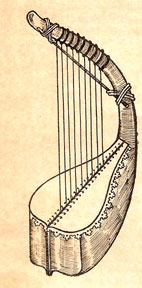How Yarlpanam got its name
by Subashini Pathmanathan
 Many ancient Tamil musical instruments are now not in use. With the
passage of time, many new musical instruments take the place of old
ones. Earlier the musicians were called Paawalar and the dancers
Koothier. Many ancient Tamil musical instruments are now not in use. With the
passage of time, many new musical instruments take the place of old
ones. Earlier the musicians were called Paawalar and the dancers
Koothier.
In ancient times, male musicians were known as Paanar and female
musicians Paanathiyar. Those who danced to their music were called
Koothar. Female dancers were called Koothiyar or Vraliyar.
During those days, even the lands were divided into five categories
according to the landscape, climatic conditions and the nature of the
land.
The five categories were Kurinchi,(mountain and mountainous area),
Mullai (forest and forest area), Marutham (paddy field and paddy field
area), Paalai (desert and desert area), Neithal (sea and seaside area).
The categories of lands had each distinct (Pun Isai ) music, as well as
different musical instruments, including leather drums, string
instrument and wind instruments.
In the Tamil cultural history the instruments were divided into four
main categories Thatha, Shasesra, Avanththatha and Gana. Thatha was a
string instrument, Shsesha was a wind instrument, Avanththatha was a
leather instrument and Gana was a metal based instrument such as the
hand cymbals.
History of Jaffna
Yarlpana Vaipava Malai, the history of Jaffna, was written by
Mayilvagana Pulavar, a Tamil poet. The Tamil encyclopaedia
Kalaikalanjeyam has confirmed this fact.
|

The Yarl instrument |
However, Yarlpana Vaipava Malai contained some crucial historical
facts of the ancient Tamil city of Jaffna. It was translated from Tamil
into English by C. Brito and published in 1879.
The ancient Yarl instrument is the main cause to name Jaffna as
Yarlpanam in Tamil and Yapanaya in Sinhala.
In ancient Tamil literature the musician was called Pannan. According
to ancient Tamil history a blind Pannan Veera Raghavan came from Chola
to the north of Sri Lanka during the reign of king Jeyathunga Veera
Singhan. As there was a tradition that the ruling king did not meet
blind people Pannan Veera Raghavan was not allowed to perform before the
king.
However, a curtain was drawn between the king and the blind musician.
The king gave him a plot of land known as Manatri.
Thereafter, Pannan Weera Raghavan came to be known as Yarlpadi (Yarl
instrument musican).
The land gifted to him was known as Yarlpanam. During the Portuguese
period the land was renamed as Jaffna. Even today Jaffna is often
referred to in Tamil as Yarlpanam or Yarl.
A few years before the war against terrorism the symbol of Yarl was
depicted on top of the Town Hall building. At night the Yarl instrument
was beautifully decorated with colour lights.
According to the ancient Tamil cultural history the Yarl instrument
implies the historical link of Yarl with the flat land. However, the
string instrument is no longer in use today. One reason for its
disappearance is that it was a heavy instrument.
Later, the Veena and Violin replaced the Yarl. Earlier there were
many varieties of the Yarl in use. They were Sakoda yarl, Senkodi yarl,
Makara Yarl, PeeriYarl, Athi Yarl and Ariya Yarl.
Each Yarl instrument had a number of strings.
The total number of strings for Sakoda Yarl was about 14. Senkodi
yarl had 17 strings. Peeri yarl had three varieties of strings.
The strings were divided according to their thickness. Each string
had only one particular pitch. But today's string instruments can
produce many pitches on one string.
Makara Yarl was often referred to in literaturue as Makara Veena. It
had its origin in Greece and was later introduced to the East. The shape
of the Makara Yarl is that of a fish.
Numerous ancient temple pillars of South Indian temples depict the
yarl instrument.
Famed Sri Lankan scholar Vipulanada Adikal did major research about
the instrument. According to him, the Ariya Yarl had 1,000 strings. The
size of the Yarl was over six feet.
The second century Silapathikaram of Illango Adikal is the oldest
Tamil epic which contained numerous references to dance, drama, and
other literary works.
The commentator of Silapathikam Adiyarkunallar of the 13th century
also wrote about the Ariya Yarl. His research on the Yarl was published
in Yarl Noo.
Yaya Padal or Kailayamalai reveal many facts about Yarl in relation
to Yarlpanam. |


